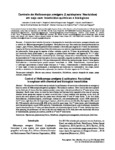Please use this identifier to cite or link to this item:
http://www.alice.cnptia.embrapa.br/alice/handle/doc/1053357| Title: | Controle de Helicoverpa armigera (Lepidoptera: Noctuidae) em soja com inseticidas químicos e biológicos. |
| Authors: | KUSS, C. C.  ROGGIA, R. C. R. K.   BASSO, C. J.   OLIVEIRA, M. C. N. de   PIAS, O. H. de C.   ROGGIA, S.   |
| Affiliation: | CASSIANO CARLOS KUSS, UFSM; REJANE CRISTINA ROPPA KUSS ROGGIA, Autônoma. Londrina-PR; CLAUDIR JOSÉ BASSO, UFSM; MARIA CRISTINA NEVES DE OLIVEIRA, CNPSO; OSMAR HENRIQUE DE CASTRO PIAS, UFSM; SAMUEL ROGGIA, CNPSO. |
| Date Issued: | 2016 |
| Citation: | Pesquisa Agropecuária Brasileira, Brasília, DF, v. 51, n. 5, p. 527-536, maio 2016. |
| Description: | RESUMO: O objetivo deste trabalho foi avaliar o desempenho de inseticidas autorizados emergencialmente para o controle de Helicoverpa armigera (Lepidoptera: Noctuidae) em soja. Sete inseticidas foram pulverizados em campo e, após 24 horas, folhas do ponteiro foram coletadas e oferecidas para lagartas de 2o instar em laboratório. Lagartas do 4o instar receberam a última folha trifoliolada que se encontrava completamente expandida no momento da pulverização. Outro grupo foi exposto a folhas coletadas a partir de 72 horas da pulverização. Em campo, seis inseticidas foram pulverizados e, em seguida, as plantas foram infestadas com lagartas de 2o e 3o instar. No primeiro estudo, flubendiamida, clorantraniliprole, clorfenapir, indoxacarbe e metoxifenozida causaram 100% de mortalidade do 4o instar aos oito dias após o início da exposição, enquanto baculovírus e Bacillus thuringiensis (Bt) propiciaram mortalidade de 60-75%, que evoluiu para 88?90% ao final da fase de pupa. Para o 2o instar, apenas flubendiamida e clorantraniliprole proporcionaram mortalidade de 100%. Flubendiamida, clorantraniliprole e clorfenapir apresentaram o menor tempo letal para o 4o instar, e flubendiamida e clorantraniliprole, para o 2o instar. Após 72 horas da pulverização, o desempenho dos inseticidas foi insatisfatório. Em campo, houve eficiência satisfatória de flubendiamida, espinosade, baculovírus e Bt sobre lagartas de 2o e 3o instar. ABSTRACT:The objective of this work was to evaluate the performance of insecticides authorized on an emergency basis to control of Helicoverpa armigera (Lepidoptera: Noctuidae) in soybean. Seven insecticides were sprayed on the field and, 24 hours after that, soybean pointer leaves were collected and offered to 2nd instar larvae in the laboratory. Fourth instar larvae received the last trifoliate leaf that was fully expanded at the time of spraying. Another larvae group was exposed to leaves collected from 72 hours onwards after spraying. In the field, six insecticides were sprayed, and then the plants were infested with 2nd and 3rd instar larvae. In the first study, flubendiamide, chlorantraniliprole, chlorfenapyr, indoxacarb, and methoxyfenozide caused 100% mortality of the 4th instar, eight days after the beginning of exposure, while baculovirus and Bacillus thuringiensis (Bt) caused 60–75% mortality, which reached 88–90% at the end of the pupal stage. For 2nd instar larvae, only flubendiamide and chlorantraniliprole caused 100% mortality. Flubendiamide, chlorantraniliprole, and chlorfenapyr showed the lowest lethal time for the 4th instar, and flubendiamide and chlorantraniliprole for the 2nd instar. Seventy-two hours after spraying, the performance of insecticides was not satisfactory. In the field, there was satisfactory efficiency of flubendiamide, spinosad, baculovirus, and Bt on 2nd and 3rd instar larvae. |
| Thesagro: | Praga de planta Soja Inseticida Lagarta |
| NAL Thesaurus: | Helicoverpa armigera Soybeans Plant pests Crop entomology Insecticides |
| ISSN: | 0100-204X |
| DOI: | 10.1590/S0100-204X2016000500013 |
| Type of Material: | Artigo de periódico |
| Access: | openAccess |
| Appears in Collections: | Artigo em periódico indexado (CNPSO)  |
Files in This Item:
| File | Description | Size | Format | |
|---|---|---|---|---|
| 208191120891PB.pdf | 491.83 kB | Adobe PDF |  View/Open |









